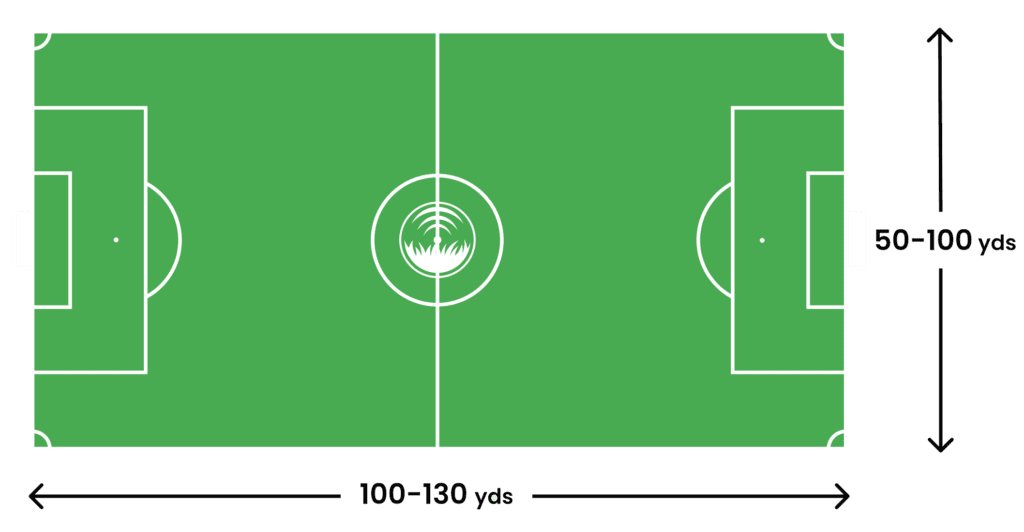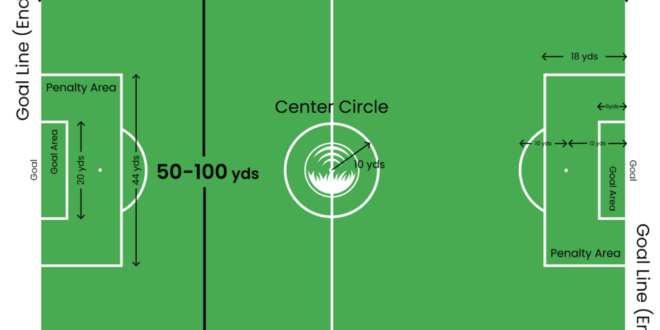A professional soccer field typically ranges from 100 to 130 yards in length and 50 to 100 yards in width. FIFA standard sizes are usually 110–120 yards by 70–80 yards for international matches.
Exploring the realm of soccer reveals the significance of playing on a field that conforms to professional standards. As the game’s heartbeat, the field’s dimensions play a crucial role in dictating the pace and style of play. Clubs and international teams perform on pitches that must adhere to regulations set forth by governing bodies.
Soccer enthusiasts and aspiring players alike appreciate the consistency this brings to the game, ensuring fairness and uniformity across competitions. Understanding these specifications is essential for architects, groundskeepers, and fans, contributing to the sport’s integrity and excitement. The field’s size impacts everything from player conditioning to tactical approaches, making it more than just a playing surface; it’s a foundational aspect of the sport’s character.
🔴Size of Professional Soccer Field🔴
Table of Contents
Diving Into The Dimensions
Have you ever wondered how big a professional soccer field is? The size of the field makes a massive difference in how the game unfolds. Let’s explore the precise dimensions that professionals play on and see how they compare to amateur fields.
Regulatory Body Standards
When it comes to professional soccer, every inch of the field matters. Strict guidelines set by the International Football Association Board (IFAB) paint a clear picture. FIFA also ensures global consistency in professional matches. These standards include:
- A length ranging from 100 to 110 meters (110-120 yards)
- A width varying between 64 and 75 meters (70-80 yards)
- Goal areas and penalty boxes specified to precise measurements
- Center circles and corner arcs with set radii
These dimensions create a playing environment that’s both challenging and fair for top-tier soccer talent.
Professional Vs. Amateur Fields
Professional fields boast meticulous maintenance and size regulations. In contrast, amateur fields can significantly vary. Here’s a quick glance at the typical differences:
| Professional Fields | Amateur Fields | |
|---|---|---|
| Size | Consistently within regulatory standards | Often smaller due to space restrictions |
| Turf Quality | High-quality grass, often hybrid varieties | Varies from grass to synthetic materials |
| Maintenance | Regular, with a professional grounds team | Mixed, dependent on local resources and care |
Even though amateur fields differ, soccer’s beauty lies in its adaptability to diverse playing surfaces.

A Range, Not A Constant
Many soccer fans believe all professional fields are the same size. It’s a common misconception. Soccer pitches actually vary within set parameters. This isn’t due to a lack of standards. In fact, international guidelines allow this variation. Teams and stadiums use these guidelines to determine the exact size of their playing field. Let’s explore the minimum and maximum sizes allowed and what causes this variation.
Minimum And Maximum Sizes
According to FIFA, a soccer field must fit within certain dimensions. For length, the minimum is 100 meters and the maximum is 110 meters. As for width, the limits are between 64 and 75 meters. This range means that different fields can have unique sizes. Yet, they all fall within an acceptable global standard.
- Length: 100m (minimum) to 110m (maximum)
- Width: 64m (minimum) to 75m (maximum)
Here’s a quick look at what that means:
| Dimension | Minimum Size | Maximum Size |
|---|---|---|
| Length | 100m | 110m |
| Width | 64m | 75m |
Every professional field fits these requirements. They keep the game fair and consistent. But each pitch can be unique.
Influencing Factors For Variation
How does a field’s size get decided? Several factors play a part.
- Stadium Design: The shape and size of the stadium can restrict field dimensions.
- Playing Style: Teams may prefer certain field sizes to suit their tactics.
- Climate: Weather patterns can impact how grass grows and field size.
- League Regulations: Different leagues might enforce unique restrictions.
These factors ensure each professional soccer field has its own character. But they all stay within the rules of the game. This makes each match an exciting and unique experience.
Remember, the size can always fall between those numbers. But it’s never just one-size-fits-all. Each pitch tells a story. Its size is part of that tale.
Markings On The Pitch
When fans cheer on their favorite soccer teams, they often overlook an essential element of the game: the pitch. A well-marked soccer field is crucial for fair play. Let’s dive into the different lines and boxes and their significance.
Lines And Boxes
Every professional soccer field features specific lines and markings. These lines and boxes keep the game orderly. Let’s explore these vital components:
- The Touchlines: These are the longest lines on the field. They define the length of the pitch.
- The Goal Lines: They mark the width of the field and where the goals sit.
- The Centre Circle: This circle, in the middle of the field, is where the game starts.
- The Penalty Area: Also known as the ’18-yard box,’ this area is critical for determining fouls and penalties.
- The Goal Area: This smaller box within the penalty area is where the goalkeeper can handle the ball.
- The Penalty Spot: Located within the penalty area, this is where penalty kicks take place.
- The Corner Arc: Small quarter-circle curves at each corner, for corner kicks.
The Significance Of Markings
The markings on a soccer pitch are not mere decorations. They serve key roles in the game:
- Ensuring Fair Play: Clear lines help referees make accurate decisions.
- Guiding Players: Athletes use these markings to position themselves and strategize.
- Ruling Set Pieces: They dictate where free kicks, corner kicks, and penalties occur.
The Grass Beneath The Game
An often overlooked aspect of a professional soccer field is the grass tantalizing the soles of players. The lush green carpet they compete on is more than just a surface. It is a crucial player in the game’s dynamics. Performance and safety of athletes highly rely on this grassy foundation. Let’s explore how the types of turf and maintenance practices significantly impact the sport.
Types Of Turf
Not all soccer fields come with the same type of grass. Various options serve different climates and usage levels. Natural grass remains popular for its softness and traditional flair. Yet, artificial turf gains favor for its durability and lower upkeep. Blends of grass, like hybrid turfs, combine the benefits of both. Artificial fibers intertwine with natural grass to boost field strength. Clubs select the type that best fits their geographic and play requirements.
Maintenance Practices
Maintaining a professional soccer field is critical. Proper care ensures a flat, consistent playing surface. Regular mowing keeps the turf at an optimal height to prevent injuries. Aerating the soil helps roots grow deep and strong. Fertilizing ensures the grass receives the nutrients it needs. A well-maintained field helps minimize game disruptions and improves the overall pace of play. Detailed attention to the turf’s condition translates to high-caliber match experiences for players and fans alike.
Goal Posts And Nets
The goal structure is a key element of any soccer field. Goals must be sturdy and the net must catch the scored balls. Let’s explore the standard sizes and some innovative designs in goal posts and nets.
Standard Measurements
Goals are crucial in soccer games. Here’s what they look like:
- Width: 8 yards (7.32 meters)
- Height: 8 feet (2.44 meters)
- Posts and crossbar are made of wood, metal, or other approved materials.
- Nets must be attached to the posts, crossbar, and to the ground behind the goals.
These measurements ensure fair play across all professional matches.
Innovations In Design
New technologies are changing goals:
- Materials: Improved durability and strength
- Smart nets can detect ball crossings for accurate scoring.
- Designs that reduce injuries on collision are coming into use.
- Foldable goalposts make transport and storage easier.
Teams and venues are constantly looking for safer and more convenient goal solutions.
Stadium Capacities And Layout
The size of a professional soccer field might seem uniform, but it’s the stadiums around them that offer variety and character. Stadium capacities and layouts differ, catering to the needs of the audience and the spectacle of the game. Fans seek memorable experiences and unobstructed views, while clubs need revenue from ticket sales.
Balancing Field Size And Audience
Designing a stadium is about finding harmony. The field must meet regulatory sizes, but architects must also consider the number of fans they can accommodate and how each one experiences the game. A well-balanced stadium offers a spacious field for players and maximum seating without compromising the view.
- Ideal capacity ranges from 20,000 to over 80,000.
- Ensuring every seat has a clear view is crucial.
Examples From Famous Stadiums
Let’s dive into some iconic examples. The nuances of how these stadiums accommodate fans while offering stellar views are extraordinary.
| Stadium Name | Capacity | Field Size |
|---|---|---|
| Wembley Stadium | 90,000 | 105m x 68m |
| Camp Nou | 99,354 | 110m x 73m |
| Maracanã Stadium | 78,838 | 105m x 68m |
Each stadium reflects intelligent design, maximizing audience numbers and maintaining qualitative experiences.
Technology Impact On Field Size
Imagine a soccer field. Technology is changing its size. New tech helps referees make better calls. This is changing soccer. Let’s dive into how.
Var And Goal-line Technology
VAR stands for Video Assistant Referee. It uses cameras. They help make decisions in soccer. Now the field size is more important. Cameras must see all lines clearly. Lines can’t be too thick or thin. Goal-line tech also uses cameras. It tells if the ball crosses the line. This means lines and goals must be perfect.
- Referees use screens to review plays.
- Better calls lead to fair games.
- Field lines are key for tech to work.
Future Trends And Considerations
Soccer fields may change soon. Tech will get even better. Fields might adapt to new rules. Players could wear tech to track them. This will help measure their work. Fields must fit this new tech. It’s an exciting time for soccer.
- Soccer fields can change shape.
- New rules might need new field sizes.
- Player tracking could be normal soon.
Tech makes soccer fair and fun. It ensures every inch of the field counts. Fans, players, and referees all benefit. The future holds more changes. Soccer fields must be ready.

Beyond The Field: Supplementary Facilities
The size of a professional soccer field tells just part of the story. Off the pitch, a network of integral facilities plays a critical role in the success of a team. These areas equip players with everything they need to train, prepare, and recuperate. Let’s delve into these essential spaces that are just as vital as the field itself.
Training Grounds
Elite soccer teams boast high-tech training grounds. Here, state-of-the-art equipment and facilities ensure peak athletic performance. Consider the following:
- Pristine practice fields: Multiple surfaces mimic match conditions.
- Indoor halls: Weather does not disrupt the training schedule.
- Gym areas: Customized strength and conditioning sessions take place.
- Recovery zones: Players relax muscles in swimming pools and spas.
- Tactical rooms: Teams strategize using the latest technology.
Player Amenities
Quality amenities contribute to player well-being and morale. Modern soccer clubs provide:
- Comfortable locker rooms: Personalized lockers store gear securely.
- Nutrition centers: Dieticians curate meals to fuel athletes.
- Lounge areas: Players unwind and build team camaraderie.
- Medical suites: Injuries are treated with advanced medical care.
- Media studios: Press activities occur without leaving the facility.
Comparative Dimensions: Soccer Vs. Other Sports
The size of a professional soccer field stands out in the sprawling landscape of sports. Each sport has its unique dimensions, tailored to its gameplay and rules. This section will explore how a professional soccer field sizes up against fields used in other popular contact sports: rugby and American football.
Soccer vs. Rugby
Soccer Vs. Rugby
When we compare soccer to rugby fields, notable differences emerge. Here’s a brief rundown:
- Soccer fields are rectangular, while rugby fields include a distinct H-shaped goalpost at each end.
- The length of soccer fields ranges from 100 to 110 meters, slightly longer than rugby fields that extend 94 to 100 meters.
- Width-wise, soccer fields measure 64 to 75 meters across; rugby fields are narrower at 68 to 70 meters.
Soccer offers a larger playing surface, which impacts game play style and strategies.
Soccer vs. American Football
Soccer Vs. American Football
Soccer and American football fields appear similar but have key distinctions:
| Soccer | American Football | |
|---|---|---|
| Field Length | 100 to 110 meters | 120 yards (109.7 meters) |
| Field Width | 64 to 75 meters | 53 1/3 yards (48.8 meters) |
| End Zone Area | Not applicable | 10 yards deep (9.1 meters) |
In contrast, the American football field includes an end zone for scoring, which soccer does not have. This affects field length and the nature of scoring.

Regulation Updates And Trends
The world of professional soccer is constantly evolving, and alongside it, the regulations governing the sport see periodic adjustments. Size variations in soccer fields are subject to regulation updates, impacting how the game is played at professional levels. Trends and standards both old and new shape the experience of players and fans alike.
Historical Changes
The dimensions of soccer fields have not always been consistent. The earliest fields varied greatly in size and shape. As the sport gained popularity, the need for standardization became clear. FIFA, the international governing body for soccer, now mandates specific guidelines. These rules ensure fair play and maintain uniformity across the globe.
- Original fields were vastly different in size.
- The International Football Association Board (IFAB) established rules.
- Current dimensions: 100-110 meters in length and 64-75 meters in width for professional play.
Impact On The Sport
The set dimensions have a significant influence on soccer’s dynamics. Larger fields may benefit teams that emphasize stamina and speed, while smaller ones could advantage those with a focus on control and technique. The playing style and strategies often hinge on the field size.
| Field Size | Playing Style | Teams Benefited |
|---|---|---|
| Larger | Fast, Endurance-based | Physically strong, well-conditioned |
| Smaller | Technical, Controlled | Strategically adept, skilled |
Frequently Asked Questions For Size Of Professional Soccer Field
What is a Standard Soccer field size?
Professional soccer fields must adhere to FIFA’s guidelines. They typically range from 100 to 130 yards in length and 50 to 100 yards in width. International matches have stricter ranges: 110-120 yards by 70-80 yards.
Are all Professional soccer Pitches the Same size?
No, they vary within allowed limits. Professional soccer pitches are not uniform in size. They must fall within the minimum and maximum dimensions set by FIFA but can differ based on the stadium’s design and constraints.
How does Soccer field size affect Gameplay?
Field size influences game dynamics. Larger fields may benefit teams that emphasize passing and tactics, while smaller fields can lead to a more physical and direct style of play due to less space.
What’s the Minimum size for a Soccer field?
The minimum size for a professional soccer field is 100 yards in length and 50 yards in width. This site is permissible for non-international matches according to FIFA’s Laws of the Game.
Conclusion
Understanding the dimensions of a professional soccer field is crucial for players, coaches, and fans alike. These measurements ensure fair play and the sport’s integrity worldwide. So, next time you watch or play a match, appreciate the carefully considered space where the beautiful game unfolds.
 SMGB TODAY Sports, Movies, TV Shows
SMGB TODAY Sports, Movies, TV Shows

